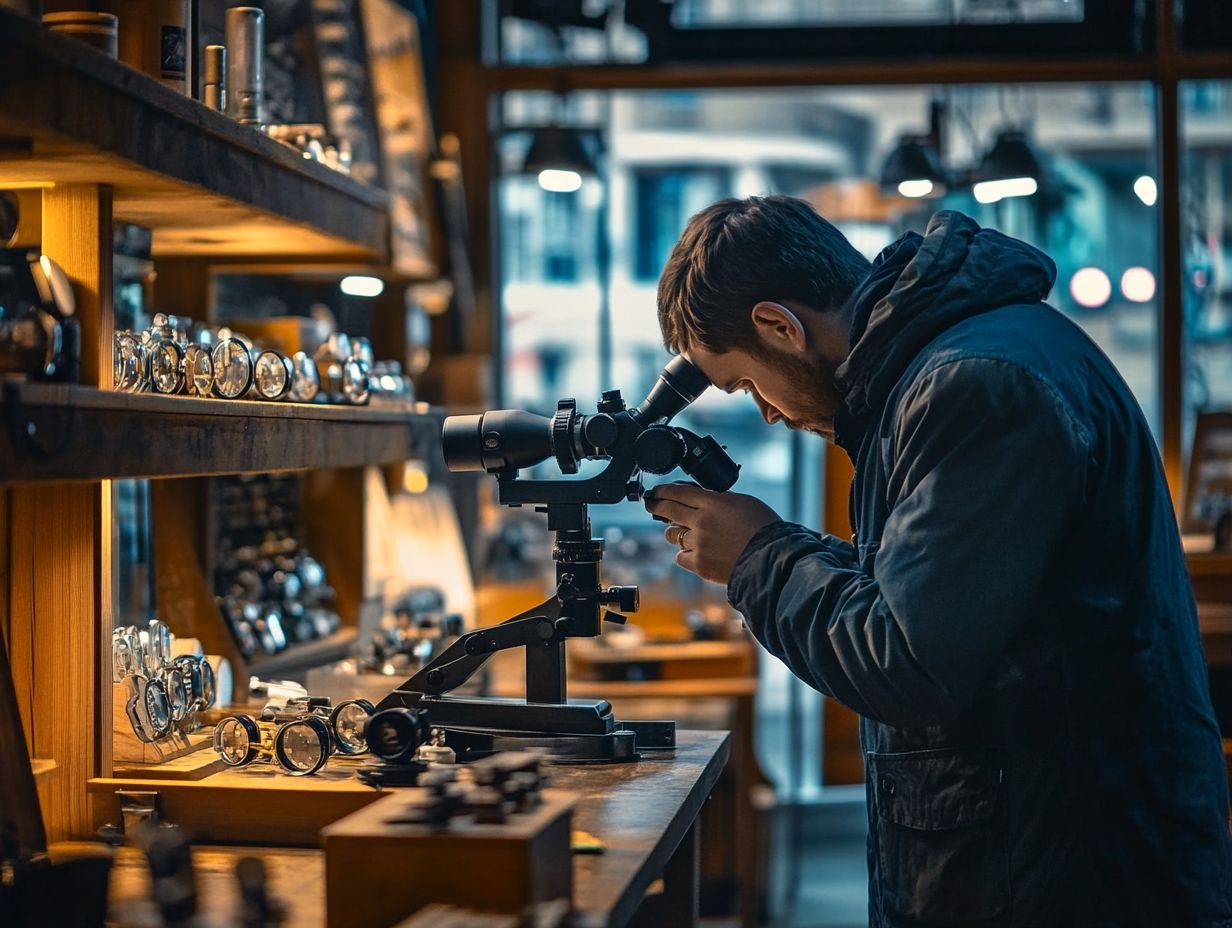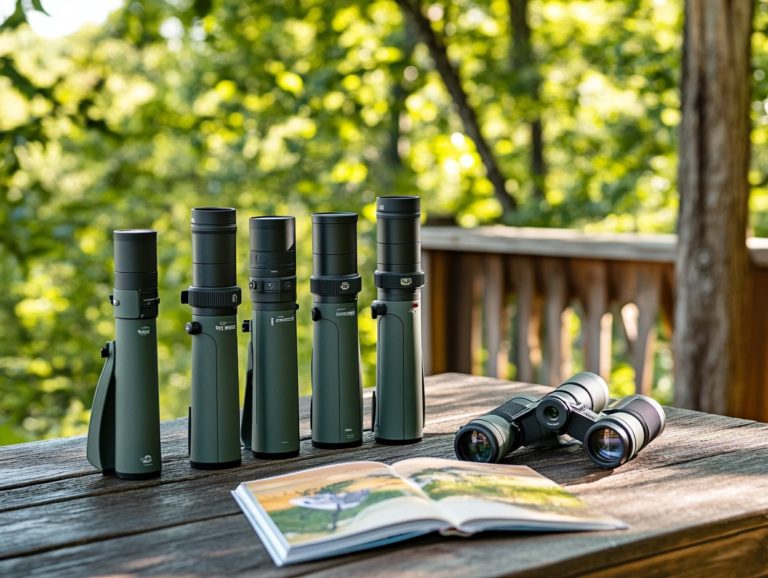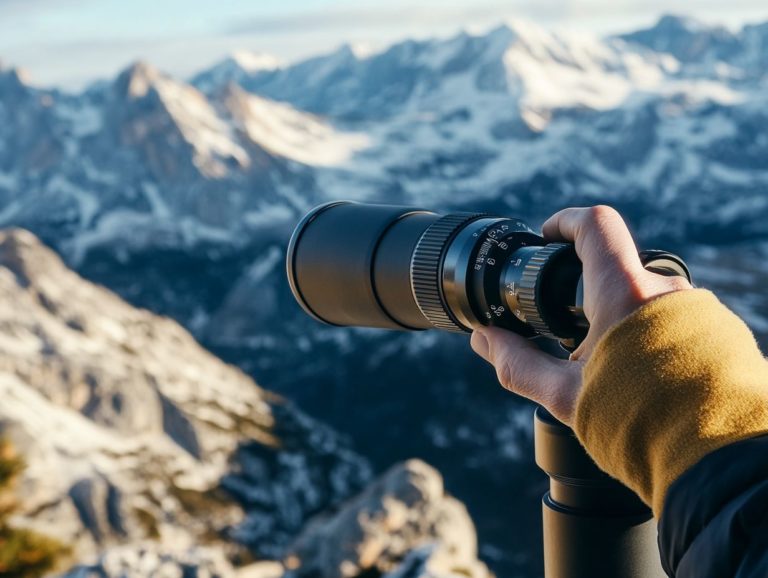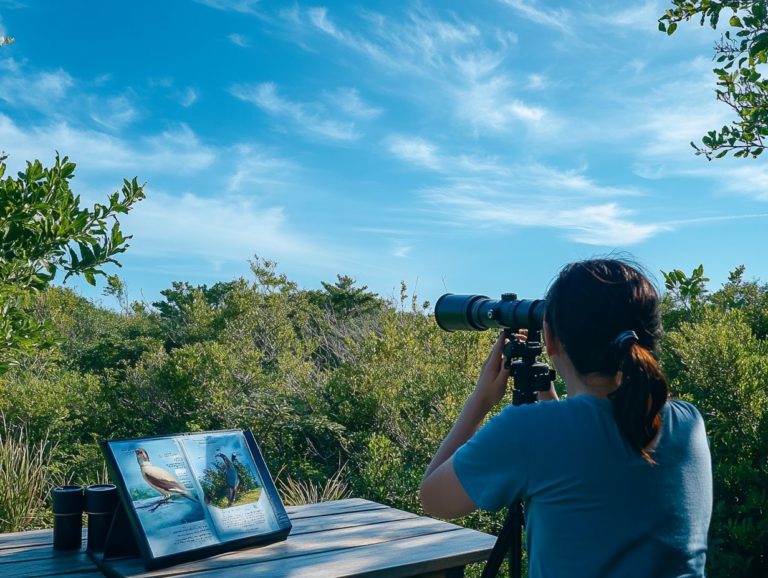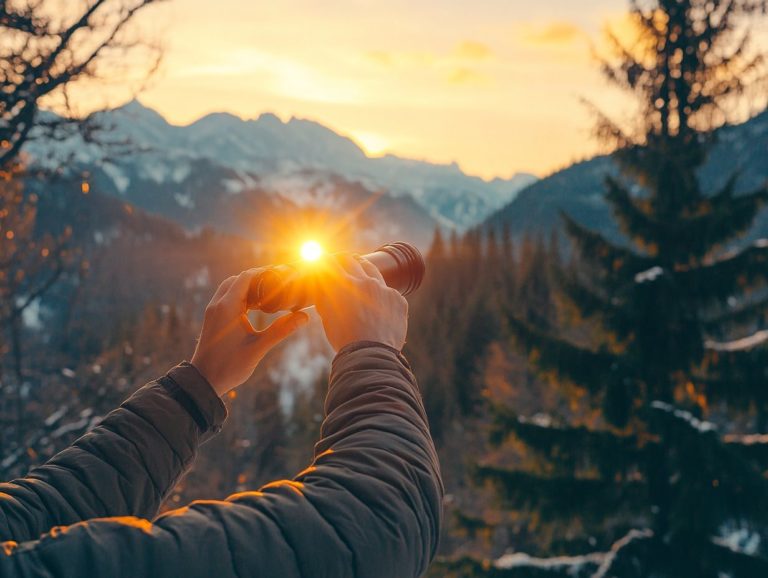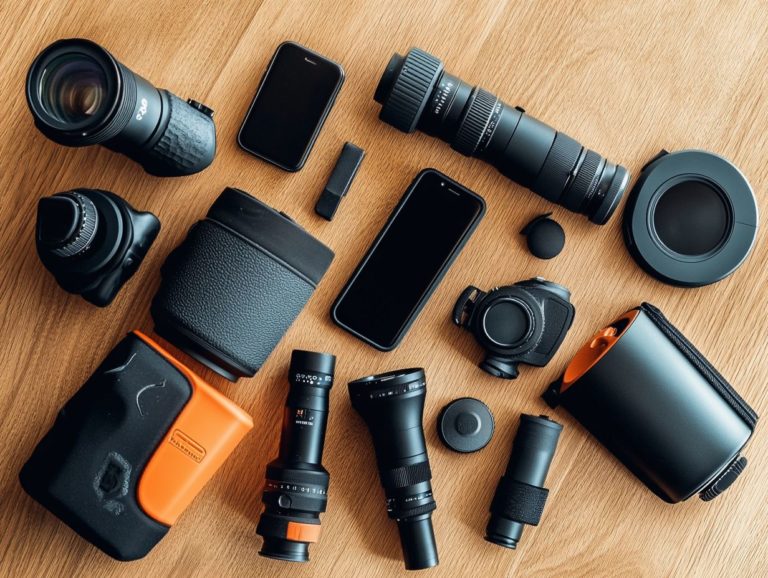What to Consider When Buying a Used Spotting Scope
Considering a used spotting scope? You re in good company! Countless outdoor enthusiasts and birdwatchers are discovering the remarkable advantages of opting for secondhand gear.
Not only can you save some cash, but you also have the chance to uncover high-quality equipment that might otherwise be beyond your budget.
Key factors to keep in mind include price, condition, and features.
It s essential to know where to find the best deals and gather tips for inspecting and negotiating your purchase.
Jump in now and discover how to score the perfect spotting scope!
Contents
Key Takeaways:
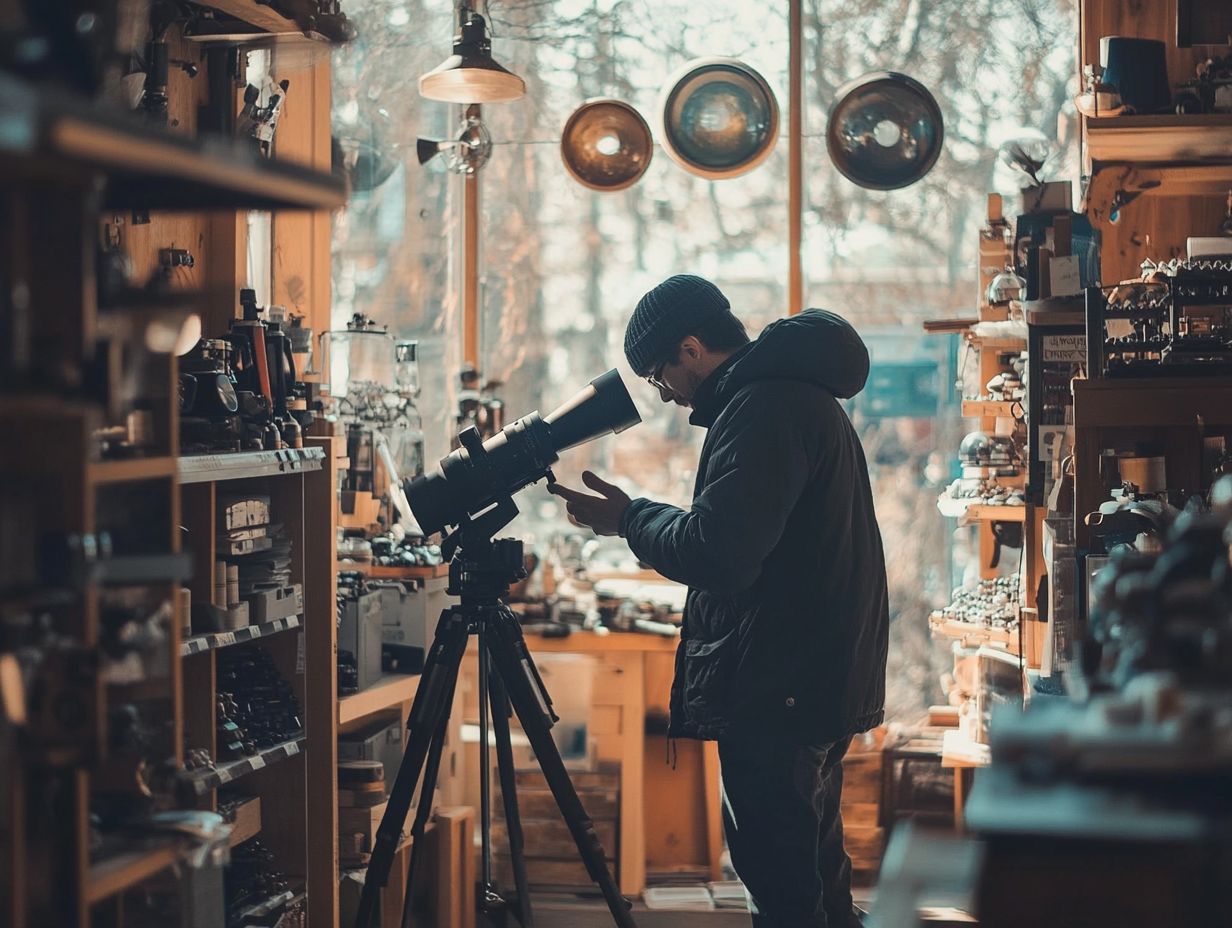
- When buying a used spotting scope, consider the price, condition, brand and model, and features and accessories.
- Look for used scopes online or in local stores and classifieds.
- Inspect the scope physically, test its optics and functionality before finalizing the purchase, negotiate for the best price, and ensure a secure transaction.
Benefits of Buying Used
Purchasing used spotting scopes opens up a world of advantages for both newcomers and seasoned enthusiasts. One standout benefit is the chance to acquire high-quality lenses at a fraction of their original cost, which is particularly enticing in the competitive secondhand market.
Whether you’re a birdwatcher in search of an affordable entry-level scope or a connoisseur hunting for a deal on premium brands like Meopta or Swarovski, used spotting scopes can fulfill your requirements without straining your budget.
Additionally, opting for used optics allows you to experiment with a variety of models and features that you might not have explored otherwise.
Factors to Consider
When contemplating the purchase of used spotting scopes, several crucial factors, such as spotting scope durability, demand your attention to ensure a well-informed decision.
First and foremost, thoroughly assess the condition of the scope. Look for any signs of damage from dirt, moisture, or scratches that could hinder its performance.
Familiarize yourself with the price ranges for various brands and models, as these can vary considerably between local sellers and online marketplaces.
Don t overlook the key features and accessories that could enhance your experience; they can significantly influence your overall satisfaction with the purchase.
Price
Price plays a pivotal role when you’re considering the purchase of used spotting scopes, as it often dictates the quality and features at your disposal. With a myriad of options on the market, you’re bound to discover a selection of secondhand scopes that align with your budget whether you’re after entry-level models or high-end optics.
Understanding market trends will empower you to spot a good deal and steer clear of overpaying for less-than-stellar equipment.
Delving into various pricing strategies is essential, as average costs can vary significantly depending on the brand and model. For example, well-known brands like Leupold and Vortex tend to command higher prices due to their reputation for quality, but they also often deliver excellent resale value.
Conversely, lesser-known brands might surprise you with their performance at a fraction of the cost. To ensure you’re getting the best bang for your buck, take the time to examine the scope’s condition, check for warranties, and compare prices across different platforms.
By exercising patience and diligence in your search, uncovering hidden gems becomes a more attainable goal, ultimately leading to a truly satisfying purchase.
Condition
The condition of a used spotting scope is crucial for its functionality and longevity. As a potential buyer, you should check meticulously for any damage, including dirt, moisture, or scratches that could affect the optics’ performance. A thorough examination guarantees you a reliable scope. It also empowers you to negotiate a fair price.
When assessing the equipment, it’s vital to inspect the glass for cloudiness or internal fogging, as these factors can severely impact clarity and image quality. Take the time to examine the focusing mechanisms and ensure smooth operation; any stiffness could indicate hidden issues. Don’t overlook the scope’s body cracks or deep scratches may suggest rough handling.
Confirming the presence of original accessories, such as lens caps and mounts, enhances the overall value and usability of the spotting scope. By paying attention to these details, you can significantly influence both your satisfaction and your return on investment.
Brand and Model
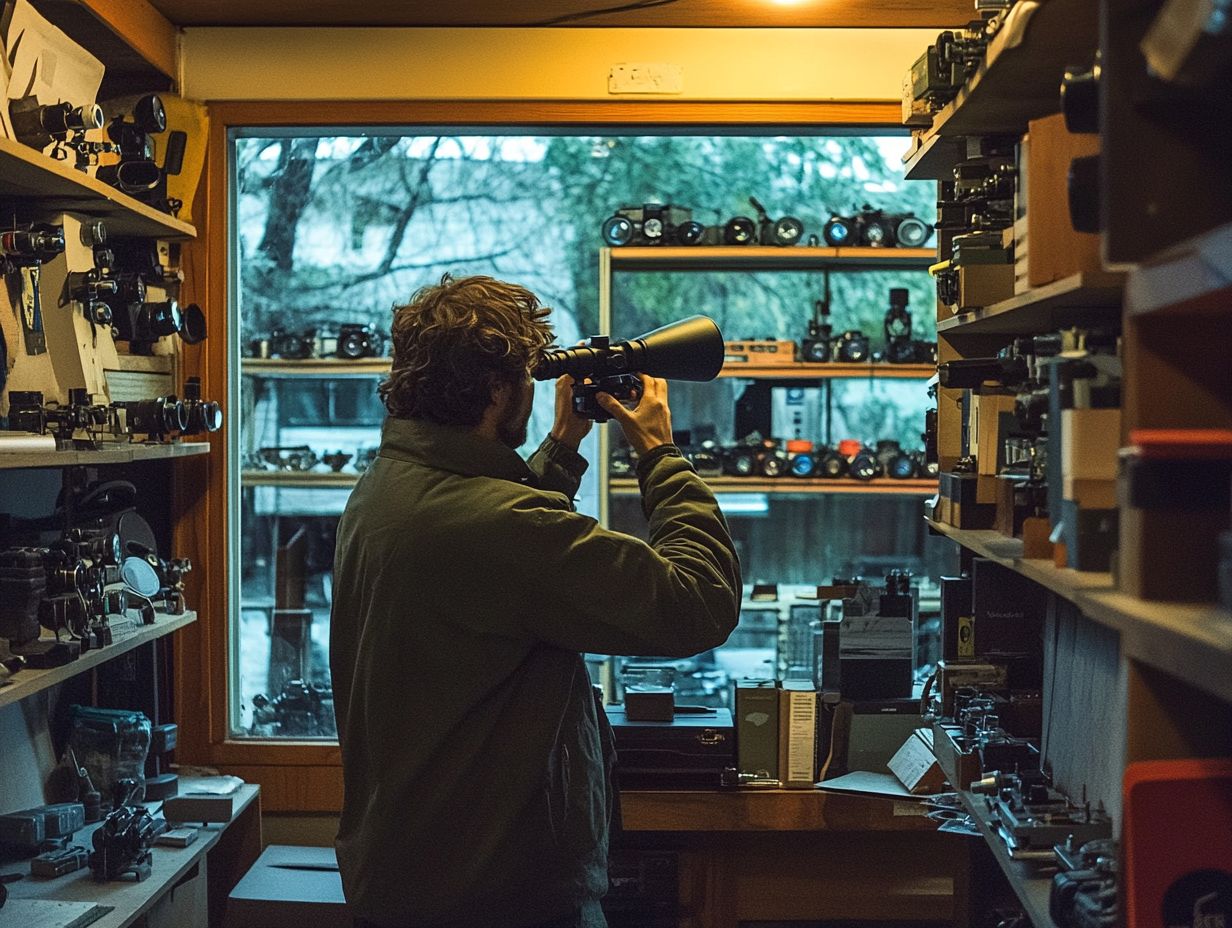
Selecting the right brand and model when purchasing used spotting scopes can profoundly impact your satisfaction and usability.
For any outdoor enthusiast or birdwatcher, a brand’s reputation serves as an essential compass; it reflects not only the quality of materials and craftsmanship but also influences performance and reliability over time.
When exploring secondhand optics, brands like Meopta and Swarovski truly stand out, boasting a history of exceptional optical clarity and durable construction. This reliability becomes especially crucial in rugged environments, where a scope must perform under varying conditions.
Explore the specifics of each model to align your scope selection with your needs. Consider factors like magnification (which refers to how much closer an object appears), lens coatings, and field of view to ensure a rewarding and enjoyable experience in the great outdoors.
Features and Accessories
Don’t miss the chance to explore the features and accessories that could elevate your viewing experience. Key aspects include:
- Magnification
- Lens coatings
- Waterproofing
These elements not only enhance usability but also ensure that the scope aligns perfectly with your specific needs be it birdwatching, hunting, or stargazing. For example, a higher magnification enables you to observe distant subjects in greater detail, while quality lens coatings can minimize glare and improve image clarity.
Features like a sturdy, adjustable tripod provide stability, making those lengthy observation sessions much more comfortable. Consider the importance of eye relief and focus mechanisms; these features can significantly influence your overall viewing experience, particularly if you wear glasses.
Where to Buy a Used Spotting Scope
Finding the ideal place to buy used spotting scopes is essential for ensuring you receive a quality product at a fair price. You have a variety of options at your fingertips, from online marketplaces like eBay and Gumtree to local stores and classified ads in your area.
Each of these platforms comes with its own unique advantages, such as the opportunity to negotiate directly with sellers or peruse an extensive selection of secondhand optics. Understanding where to shop can greatly influence your experience and overall satisfaction with your purchase.
Online Marketplaces
Online marketplaces like eBay and Gumtree offer exceptional platforms for discovering a wide variety of used spotting scopes at different price points. You can easily filter listings by brand, condition, and price, making it seamless to find the perfect scope that suits your needs. User reviews and seller ratings provide invaluable insights into the reliability of both the products and the sellers.
As you navigate these listings, it s essential to pay close attention to detailed descriptions and high-quality images, as they can reveal significant information about the item s condition. Look for scopes that come with their original packaging and accessories; such details often indicate better care and maintenance.
To evaluate seller credibility, consider examining their sales history and the feedback from previous buyers. Engaging directly with the seller can also clarify any questions you may have regarding the scope s performance or history, ensuring that you make a well-informed purchase.
Local Stores and Classifieds
Local stores and classifieds often fly under the radar, yet they can be great chances for discovering used spotting scopes. By visiting these local shops, you can physically inspect the scopes before making a purchase, allowing for a clearer assessment of their condition and functionality.
Local classifieds connect you directly with sellers in your area, creating a platform for negotiation that could lead you to lower prices.
Exploring these options gives you the power to evaluate the optical quality firsthand while also spotting any wear and tear that might escape notice in online listings. The advantages of face-to-face interaction are significant; it builds a sense of trust between you and the seller, enabling open talks about the scope s history and performance.
Negotiating in person often leads to better deals, as sellers often become more amenable to lowering their prices when they sense genuine interest. In the end, sourcing used spotting scopes locally not only saves you money but also ensures that you leave with a product tailored to your specific needs.
Tips for Inspecting a Used Spotting Scope
Inspecting a used spotting scope carefully is key to a smart purchase. Begin with a thorough physical examination, looking for any visible damage, dirt, or moisture that could hinder performance.
After that, conduct practical tests on the optics the lenses and their quality and functionality to verify that the scope meets your expectations. By following these guidelines, you can confidently evaluate the value of a secondhand scope before you seal the deal.
Physical Examination
Conducting a thorough physical examination of used spotting scopes is your first step to making a smart purchase. Carefully inspect the exterior for any visible damage or scratches that might indicate poor handling or wear over time. Check the lens for signs of dirt or moisture; these nuisances can significantly detract from the performance and clarity of the optics.
To dig deeper, examine the scope’s body for any signs of corrosion, which can suggest exposure to moisture. Pay close attention to the eyecups the parts that rest against your eyes make sure they function smoothly and fit comfortably. While you re at it, inspect the focus mechanism. Assess its ease of use; a stiff or loose focus can really impact your viewing experience. Keep an eye out for any misalignments in the optics, as this could lead to frustrating viewing distortions.
Lastly, always review the scope s warranty or return policy. This can offer you added peace of mind in case any unseen flaws emerge after your purchase.
Testing Optics and Functionality
Testing the optics and functionality of used spotting scopes is vital for assessing their performance and reliability. Whenever possible, take the scope outdoors to evaluate its clarity, focusing ability, and field of view under various lighting conditions. Be attentive to any inconsistencies or difficulties when adjusting the settings, as these may signal underlying issues.
Observing distant objects at different times of the day can reveal how well the optics perform under changing light and atmospheric conditions. Check for chromatic aberration, which is when you see colors around the edges of objects; this can impact image quality.
A smooth and precise focus mechanism is essential. If the adjustments feel stiff or inconsistent, that could be a red flag for wear or poor design. Using these practical tips will ensure the scope meets your standards and empower you to make an informed purchase that aligns with your outdoor exploration needs.
Negotiating and Finalizing the Purchase
Ready to seal the deal on your perfect spotting scope? Let s dive into negotiation tips! Negotiating and finalizing the purchase of used spotting scopes is a refined skill that can significantly impact your overall investment. By grasping the seller’s perspective and familiarizing yourself with the market value of the scope, you position yourself to negotiate with confidence.
Equip yourself to discuss the scope’s condition and features, as this insight will enhance your standing during price and terms discussions, paving the way for a mutually beneficial agreement.
Tips for Negotiating Price
When negotiating the price of used spotting scopes, it s crucial to enter the conversation with confidence and a wealth of knowledge. Prepare to present your findings on the scope’s condition and comparable market prices. This information gives you the power to negotiate and can help establish a fair price that works for both you and the seller.
Understanding the intricacies of the spotting scope market is vital. Begin by researching recent sales of similar models to determine fair value and familiarize yourself with common issues that arise with used units.
As you engage with the seller, communicate clearly and respectfully. Point out any flaws you ve observed, like scratches or wear on the lenses. This transparency builds trust and encourages a more amicable dialogue.
Don’t shy away from asking questions about the scope s history; this can reveal insights that bolster your bargaining position, leading to a successful transaction.
Ensuring a Secure Transaction
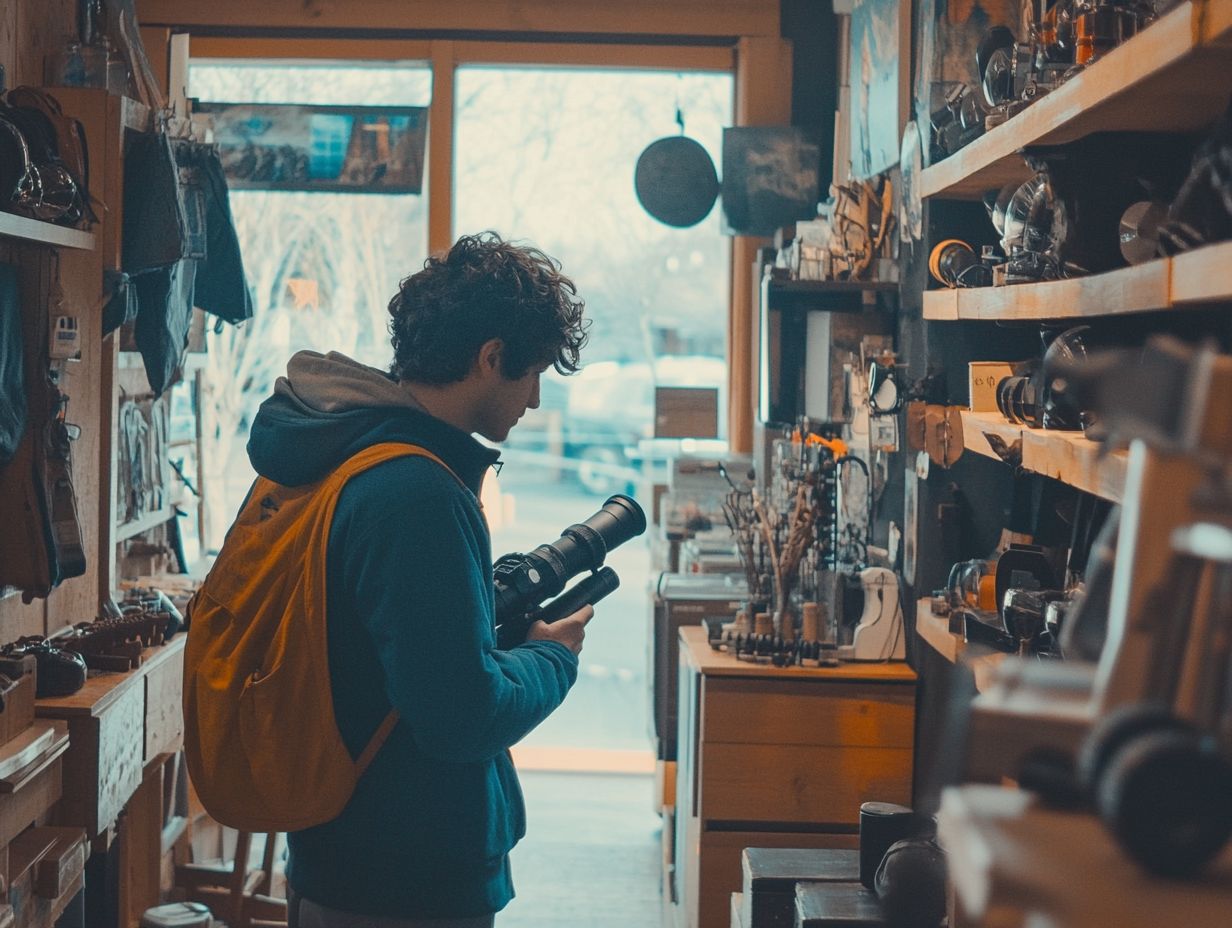
Ensuring a secure transaction when purchasing used spotting scopes is essential for safeguarding your investment. Whether you re buying online or from a local seller, check the seller’s credibility and inquire about any available warranties or return policies.
Delve into the seller’s past transactions or reviews to gain additional peace of mind regarding their reliability. Talk openly about payment methods, favoring secure options like PayPal or escrow services that provide buyer protection.
If you’re arranging a local transaction, consider meeting in a public place. This not only fosters trust but also allows you to inspect the spotting scope in person. By adhering to these best practices, you position yourself as a well-informed buyer, confidently navigating the purchasing process.
Frequently Asked Questions
What to Consider When Buying a Used Spotting Scope?
Buying a used spotting scope can be a great way to save money while still getting a quality product. However, there are a few things to consider before making your purchase.
What condition should the spotting scope be in?
When buying a used spotting scope, it’s important to check the overall condition of the scope. Look for any signs of damage or wear, such as scratches, dents, or rust. Ensure the optics are clean and clear, and that all moving parts are functioning properly.
In summary, by evaluating optics and functionality, negotiating confidently, and ensuring secure transactions, you can make a smart investment in a used spotting scope that meets your needs.
What brand and model should I look for?
Research is essential when choosing a used spotting scope. Focus on reputable brands like Vortex, Leupold, and Swarovski. Choose a model that fits your specific needs.
How old is the spotting scope?
The age of the spotting scope affects its performance. Ask the seller how old it is and if it has been well taken care of.
What accessories should be included?
Check if any accessories come with the spotting scope. Tripods, carrying cases, lens covers, and cleaning tools can add value and save you money.
Can I test the spotting scope before buying?
Always try to test the spotting scope before you buy! This lets you see the quality of the optics and ensures everything works well.
If the seller won’t allow a test, that’s a red flag consider looking elsewhere.

